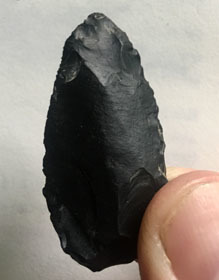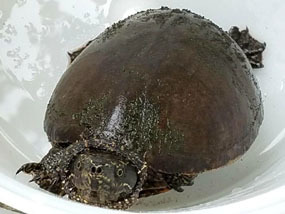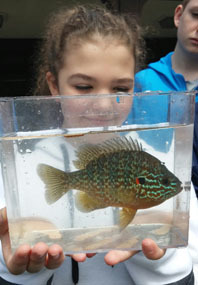Hudson River Almanac 6/3/17 - 6/9/17
The New York State Department of Environmental Conservation sent this bulletin on 06/16/2017 04:21 PM EDT |
| DEC Delivers - Information to keep you connected and informed from the NYS Department of Environmental Conservation |
| Share or view as a web page || Update preferences or unsubscribe |
|
|
Entries this week remind of the great time depth of the Hudson Valley, from a reported sighting of an animal thought to have been extirpated 100 years ago, to a stone tool that may have been used more than a thousand years ago.
HIGHLIGHT OF THE WEEK
6/4 – Yonkers, HRM 18: On a hazy afternoon, the crew of the Hudson River Sloop Clearwater watched a double-crested cormorant diving close to shore. Three times the bird came up with a hogchoker in its bill. On the first two attempts, the cormorant swallowed the fish but then coughed it up. Then the cormorant bounced it a few times, probably repositioning it, and on the third try successfully swallowed the hogchoker.
[Hogchokers are delightful little soles, ranging in size from a penny to the palm of your hand. They are found in the western Atlantic from Massachusetts to Panama. Their coloring is a mottled light and dark “squiggly” pattern of perfect camouflage and, like fingerprints and snowflakes, no two are exactly alike. If you stroke these little flatfish from head-to-tail, they are incredibly smooth. However, if you run your finger from tail to head, it will feel like the fine teeth on a saw. Eventually, cormorants will learn to swallow hogchokers head first. Tom Lake.]
NATURAL HISTORY NOTES
6/3 – Waterford, HRM 158: When you pass above the Federal Dam at Troy and leave tidewater behind, you enter into an entirely different, and very refreshing, Hudson River. If you branch off to the west and climb the Waterford Flight, you find the Mohawk River with fish fauna just different enough to lure us there to haul a seine. For us, the magic of the Mohawk is in its fishes, seeing species that are not often encountered in tidewater. Our catch today included some native fishes such as creek chub (Semotilus atromaculatus), but the others were nonnative canal immigrants from the Great Lakes and the Mississippi watershed to the west. These included bluntnose (Pimephales notatus) and fathead minnows (P. promelas), spotfin shiners (Cyprinella spiloptera), and northern logperch (Percina caprodes semifasciata). This was the spawning season, particularly obvious for the male bluntnose minnows that sported breeding tubercles on their heads. These small bumpy projection indicate a male (much less frequently female) that is sexually mature and ready to breed.
[The Waterford Flight is a series of five Barge Canal locks that rise nearly 170 feet from the Hudson to the Mohawk River. Tom Lake.]
[Photos of the two-inch-long stone tool showed a biface (worked on both sides), and is what archaeologists call a “projectile point.” In reality, this tool may have had a multitude of practical uses as a stone knife, a hide scraper, or a “preform” still being flaked on its way to becoming a spear point. The point and its characteristics do not fall into a readily identifiable “type” therefore aging was difficult. While stone tools like this one were used in the Hudson Valley for the last 12,000 years, given where and how it was found, a guess of 1,500 to 2,000 years old would be reasonable. The black smooth material (lithic), called chert, was in this instance Normanskill chert. The raw material came from Stone Age quarries either in Greene County or from the Helderberg Escarpment in Albany County. Tom Lake.]
6/3 – Manhattan, HRM 1: Participating in the third annual World Science Festival’s Great Fish Count, we checked our collection gear in early afternoon in Hudson River Park at The River Project’s sampling station on the lighthouse tender Lilac at Pier 25. Our prize catch was an oyster toadfish 190 millimeters [mm] long. A lined seahorse was hanging off a rope of a killifish trap but it fell back into the river before we could measure it. We also checked water quality and found salinity to be 10.0 parts-per-thousand, dissolved oxygen 5.6 parts-per-million, and water temperature 18 degrees Celsius (62 degrees Fahrenheit).
6/4 – Green Island, HRM 153: At high tide, shore-bound as well as boat anglers were catching the occasional striped bass. Most went back over the side. (Striped bass regulations for the Hudson River are one fish 18-28", or one fish over 40".) As you stand along the shore at Green Island it takes some imagination but you can almost visualize the spot hundreds, even thousands of years ago. Before the original dam at Green Island-Troy, completed in 1825, there was a wide plunge pool beneath a long series of rapids that gradually rose above the fall line. It was a place where sea run shad, herring, and sturgeon mingled each spring, calling on their energy reserves to get them above that last challenge. Mohicans, Mohawks, and people for whom we have no names, stood here each spring, thanking their gods for such a bounty. Today’s visualization was made more difficult because I had to also remove both dame’s rocket and Morrow’s honeysuckle. Native people did not smell the incredibly sweet fragrances of these introduced wildflowers.
6/4 – Greene County, HRM 123: I am sure that I saw a mountain lion yesterday! I spotted it as it crossed the road in front of me as I was driving. From a distance, my first thought was white-tailed deer – it was the same color. But as I got closer, I saw that long thick tail as it entered the woods.
[New York State has had three “big cats” in historic times: bobcat, Canada lynx, and the largest of the three, the Eastern cougar – also called mountain lion or puma (Puma concolor). The latter was here before the first of us arrived, but in historic times they have suffered from habitat loss and human intolerance until finally being extirpated in the early twentieth century. Statewide, recent isolated sightings involved cougars not native to New York. A couple involved captive mountain lions that escaped from licensed facilities; another involved a wild cougar that traveled through New York as it trekked nearly 1,800 miles east from its native population in South Dakota. Sightings have been reported in the Hudson Valley, but thus far they have not been supported by unambiguous evidence such as photos or physical evidence such as scat, fur, or reliable tracks. It is not beyond the realm of possibility that one or more of these enigmatic cats might be around, but if so they are surprisingly adept at consistently eluding automobiles and hunters. Visit DEC’s Eastern cougar sightings webpage for more information. Tom Lake.]
6/4 - Millbrook, HRM 82. As noted in last week’s Almanac, the local roads have been lined with dame’s rocket, a pretty invader from Eurasia. Its variation in flower color is thought to arise mostly from one or two genes, with dominant forms producing white flowers and recessive ones producing purple flowers. Another invader frequently accompanies the dame’s rocket, the white-flowered cow parsley (Anthriscus sylvestris), said to be edible and even medicinal, but it is easily confused with its poisonous relatives.
6/5 – Minerva, HRM 284: My area of Essex County was greening up nicely. Wildflowers included starflower, painted trillium, red moccasin-flower, and smooth yellow violets. I was in the “back forty” in early evening when I heard swamp sparrows, red-winged blackbirds, common yellowthroats, and something that was very satisfying: our seasonally resident American bittern. Bullhead lily was blooming in the pond and stream and pond levels were high.
6/5 – Croton-on-Hudson, HRM 34.5: Odd living arrangements and visits continued at the osprey cell tower nest. As I was walking to the Metro North commuter train this morning, I saw an osprey jump from one antenna to another and a second osprey take off (in no hurry) from the cell tower nest. Then I noticed they had company. There was a third adult osprey on the far side of the cell tower. This is the second time that I have seen three adult osprey in or very near the nest.
6/6 – Saw Kill, HRM 98.5: A June 2 Hudson River Almanac entry noted a catch of three green sunfish in the Saw Kill. After taking a second look at the fish, it was discovered that all three were redbreast sunfish – same genus (Lepomis), but a different and easily confused species. The most significant aspect of this change moves the catch from an introduced species (green sunfish) to a native species.
6/6 – Crugers, HRM 39: As we approached Ogilvie’s Pond on our daily quest to spot the great blue heron, we saw a bird fly in and land on the spatterdock. It was a gorgeous green heron. It flitted around from one floating leaf to another, occasionally flapping its wings. Most of the time it crouched down but when it stood to its full height, we could see its vibrant colors: green back, brown breast, yellow legs and eyes. We noticed its very long and sharp beak that no doubt makes it easy to capture fish.
6/7 – North Germantown, HRM 109: I went for my usual bald eagle check today at the Anchorage (Lasher Park) looking both up and down the river. There was much to see – I spotted a river otter making its way upriver along the shoreline and a three-year-old immature bald eagle cruised in to perch in a tree at the boat launch. As expected, the big bird took off the minute I reached for my camera.
6/7 – Bedford, HRM 35: I was surprised today to see two healthy-looking red squirrels chasing each other around an oak tree. This may have been the first time I had seen a red squirrel in this area in 20 years and it begged the question, what happened to the red squirrel population? Thirty years ago they were quite common in the area; perhaps the explosion of red-tailed hawks over that same period has been a factor.
[Red squirrels tend to favor coniferous forest more so than gray squirrels so it is possible that sensitivity to land use, habitat change, or a shift in the makeup of lower Hudson Valley forests, may account for their scarcity. Tom Lake.]
6/7 – Manhattan, HRM 1: We checked our collection gear in midday in Hudson River Park at The River Project’s sampling station on the lighthouse tender Lilac at Pier 25. In one of our killifish traps we found a American eel 435 mm long. We also had a rather large lined seahorse that fell off one of the crab pots. Among many invertebrates, we found a comb jelly, 49 mud dog whelk snails, a large oyster drill, four isopods, some mud crabs, and an increased number of amphipods from the past few weeks.
6/8 – Bedford, HRM 35: The young herons at the great blue heron rookery continued to grow and their down was being replaced by feathers – they are beginning to look more like their parents. Some nests still have a guardian while others have both parents away hunting for food.
6/8 – Manhattan, HRM 2: We checked our collection gear at The River Project’s Pier 40 research site and found a white perch, a small lined seahorse, a gravid mud crab, and a very large isopod (15.0 mm).
6/9 – Ulster County, HRM 85: I watched as one of the adults from bald eagle nest NY92 near Sturgeon Pool on the Wallkill River made two trips back to the nest after hunting. In the first pass heading to the nest, the adult carried a foot-long American eel. On the second pass, the eagle carried a limp gray squirrel. The nestling was being well fed.
6/9 – New Paltz, HRM 78: After a short walk through Mohonk’s foothills today, I came across a black rat snake estimated to be nearly six feet long warming itself on the road. It didn’t move with my approach so I got a chance to admire it for a while. Hearing an approaching car, I coaxed it to the shoulder of the road and into the adjacent field. [See banner photo of black rat snake courtesy of Bob Ottens.]
SUMMER 2017 NATURAL HISTORY PROGRAMS
Thursday, July 27: 7:00 PM
HUDSON RIVER MILES
The Hudson is measured north from Hudson River Mile 0 at the Battery at the southern tip of Manhattan. The George Washington Bridge is at HRM 12, the Tappan Zee 28, Bear Mountain 47, Beacon-Newburgh 62, Mid-Hudson 75, Kingston-Rhinecliff 95, Rip Van Winkle 114, and the Federal Dam at Troy, the head of tidewater, at 153. The tidal section of the Hudson constitutes a bit less than half the total distance – 315 miles – from Lake Tear of the Clouds to the Battery. Entries from points east and west in the watershed reference the corresponding river mile on the mainstem.
TO CONTRIBUTE YOUR OBSERVATIONS OR TO SUBSCRIBE
Smartphone app available for New York outdoor enthusiasts!
Copies of past issues of the Hudson River Almanac, Volumes II-VIII, are available for purchase from the publisher, Purple Mountain Press, (800) 325-2665, or email purple@catskill.net |

 Hudson River Almanac
Hudson River Almanac 6/3 – Dutchess County, HRM 85: I enjoy kayaking along this reach of the river and often see the swirling disturbances of huge fish tails lazily breaking the surface for a second or two before disappearing. I take these to be giant sturgeon. I pass deadfalls where cormorants perch and eagles fly overhead. I came ashore today for a rest and found what I thought was an ancient stone tool that had eroded out of the river bank. [Photo of projectile point courtesy of Tom Hall.]
6/3 – Dutchess County, HRM 85: I enjoy kayaking along this reach of the river and often see the swirling disturbances of huge fish tails lazily breaking the surface for a second or two before disappearing. I take these to be giant sturgeon. I pass deadfalls where cormorants perch and eagles fly overhead. I came ashore today for a rest and found what I thought was an ancient stone tool that had eroded out of the river bank. [Photo of projectile point courtesy of Tom Hall.] 6/5 – Rockland County, HRM 24.5: Our team found a small turtle this afternoon in the eel ladder recently installed at the first dam on Sparkill Creek. We were convinced that it was a common musk turtle with its smooth carapace, faint head-stripes, and a decent amount of skin around its plastron. Erik Kiviat commented that from what he can tell, musk turtles are somewhat rare in the estuary but perhaps not that rare in sluggish streams and lakes. [Photo of musk turtle courtesy of Chris Bowser.]
6/5 – Rockland County, HRM 24.5: Our team found a small turtle this afternoon in the eel ladder recently installed at the first dam on Sparkill Creek. We were convinced that it was a common musk turtle with its smooth carapace, faint head-stripes, and a decent amount of skin around its plastron. Erik Kiviat commented that from what he can tell, musk turtles are somewhat rare in the estuary but perhaps not that rare in sluggish streams and lakes. [Photo of musk turtle courtesy of Chris Bowser.] 6/7 – Norrie Point, HRM 85: The flood tide was rising quickly as students from Wappingers Junior High helped us carry our seine to the cove next to the Norrie Point Environmental Education Center. There was no time to lose. It was a teaching moment for us and a learning moment for the students: most research on estuaries is very tide dependent; the tide will not wait on the convenience of researchers. There may not be a prettier fish in the river than a banded killifish of which we caught several. With iridescent blue, lavender and silver highlights in their bands, they are sometimes called the “blue-banded mudminnow,” a colloquialism coined by riverman Everett Nack. Equally impressive were the male pumpkinseed sunfish in brilliant breeding colors including an orange abdomen, a red tab on their gill cover, and turquoise piping on their heads. The river was 63 degrees F. [Photo of male pumpkinseed sunfish courtesy of Tom Lake.]
6/7 – Norrie Point, HRM 85: The flood tide was rising quickly as students from Wappingers Junior High helped us carry our seine to the cove next to the Norrie Point Environmental Education Center. There was no time to lose. It was a teaching moment for us and a learning moment for the students: most research on estuaries is very tide dependent; the tide will not wait on the convenience of researchers. There may not be a prettier fish in the river than a banded killifish of which we caught several. With iridescent blue, lavender and silver highlights in their bands, they are sometimes called the “blue-banded mudminnow,” a colloquialism coined by riverman Everett Nack. Equally impressive were the male pumpkinseed sunfish in brilliant breeding colors including an orange abdomen, a red tab on their gill cover, and turquoise piping on their heads. The river was 63 degrees F. [Photo of male pumpkinseed sunfish courtesy of Tom Lake.]